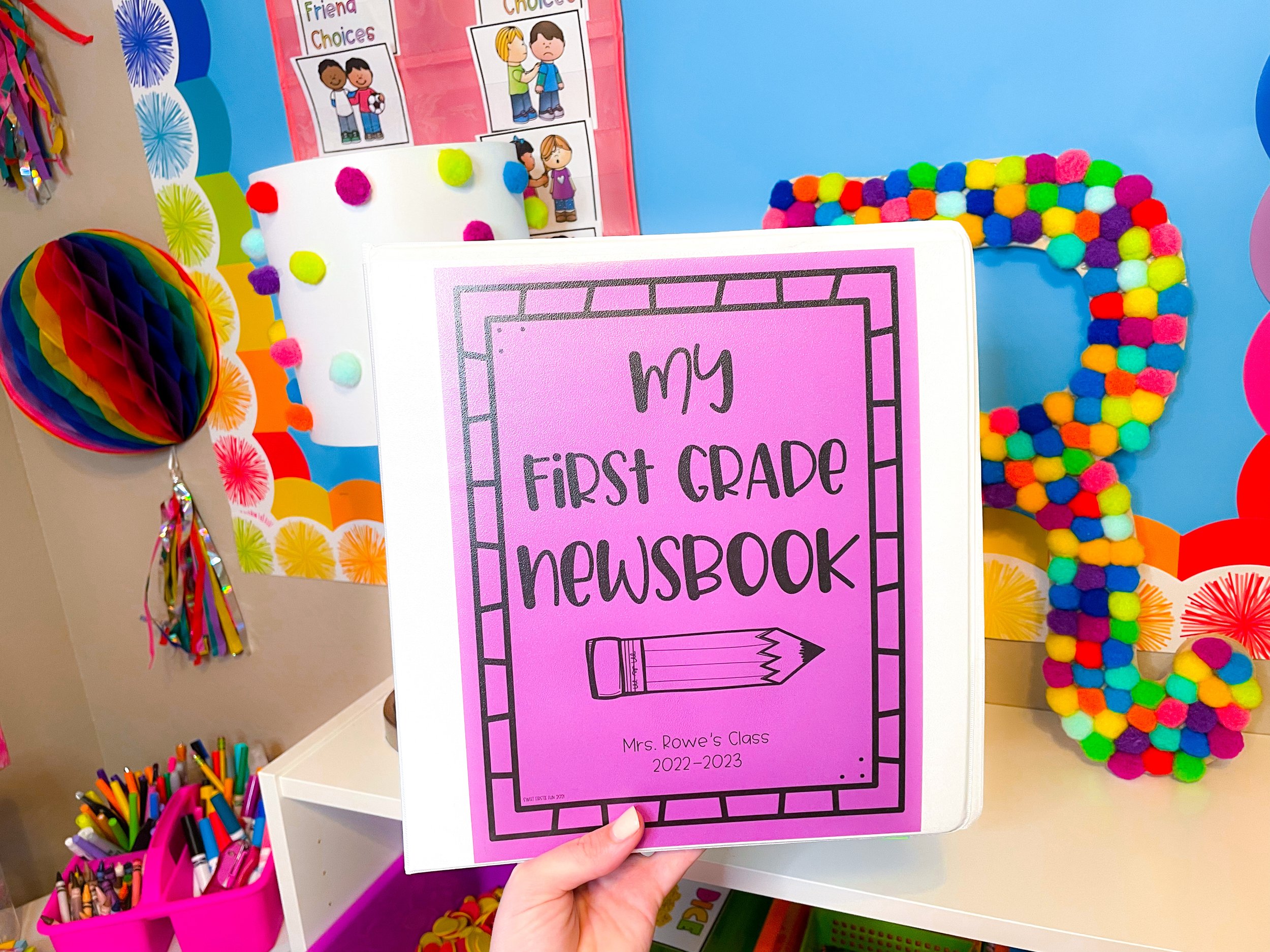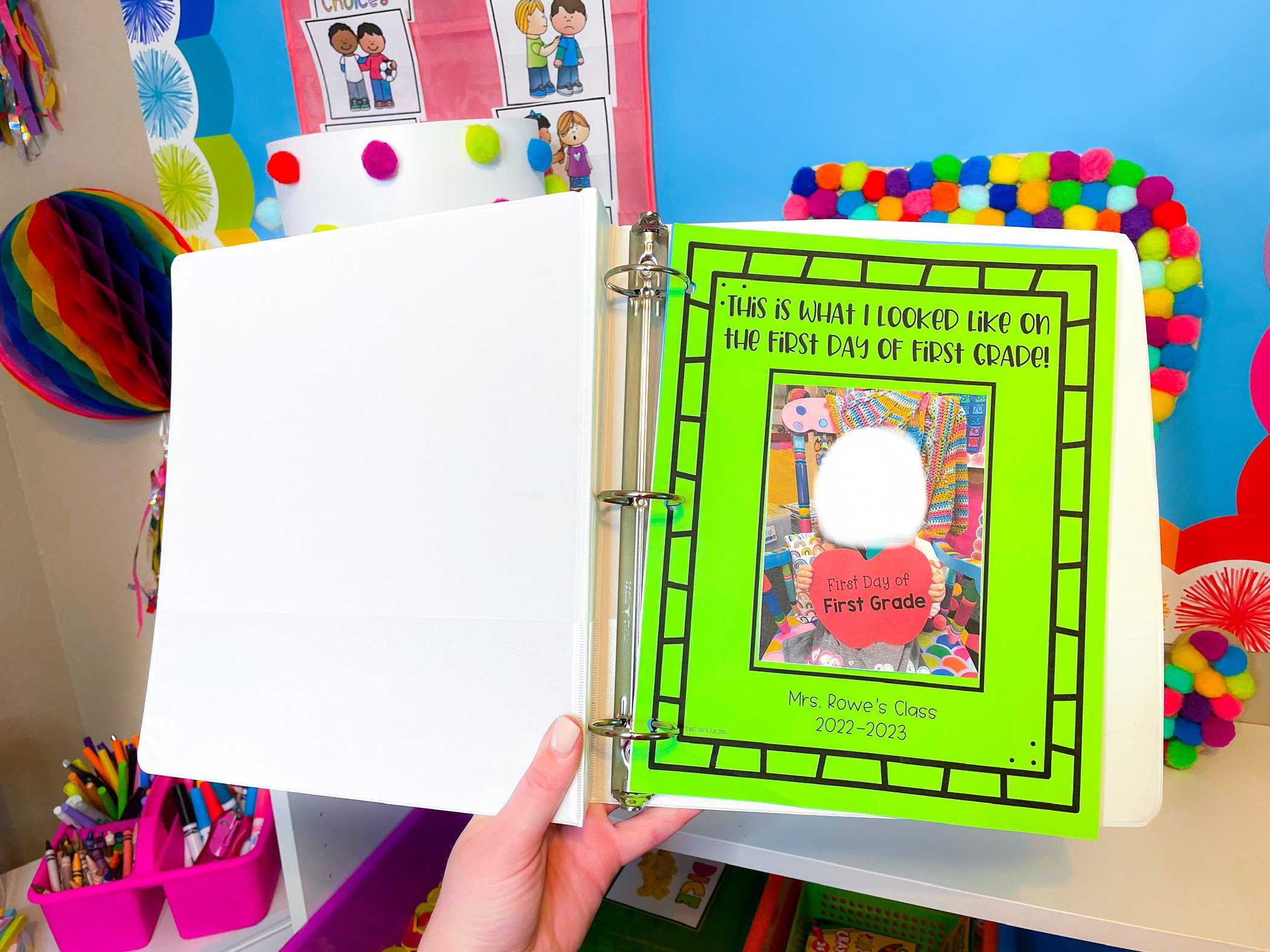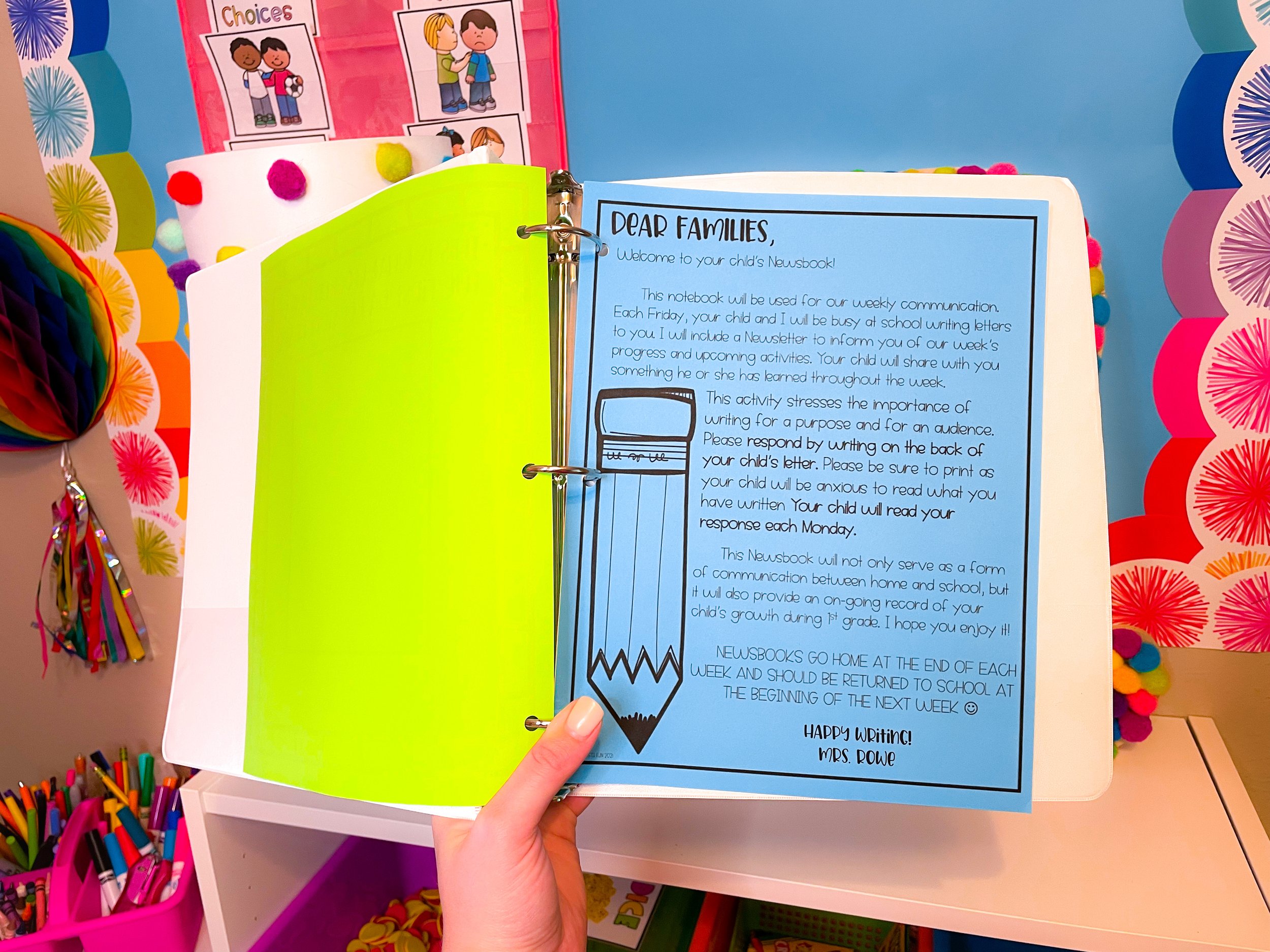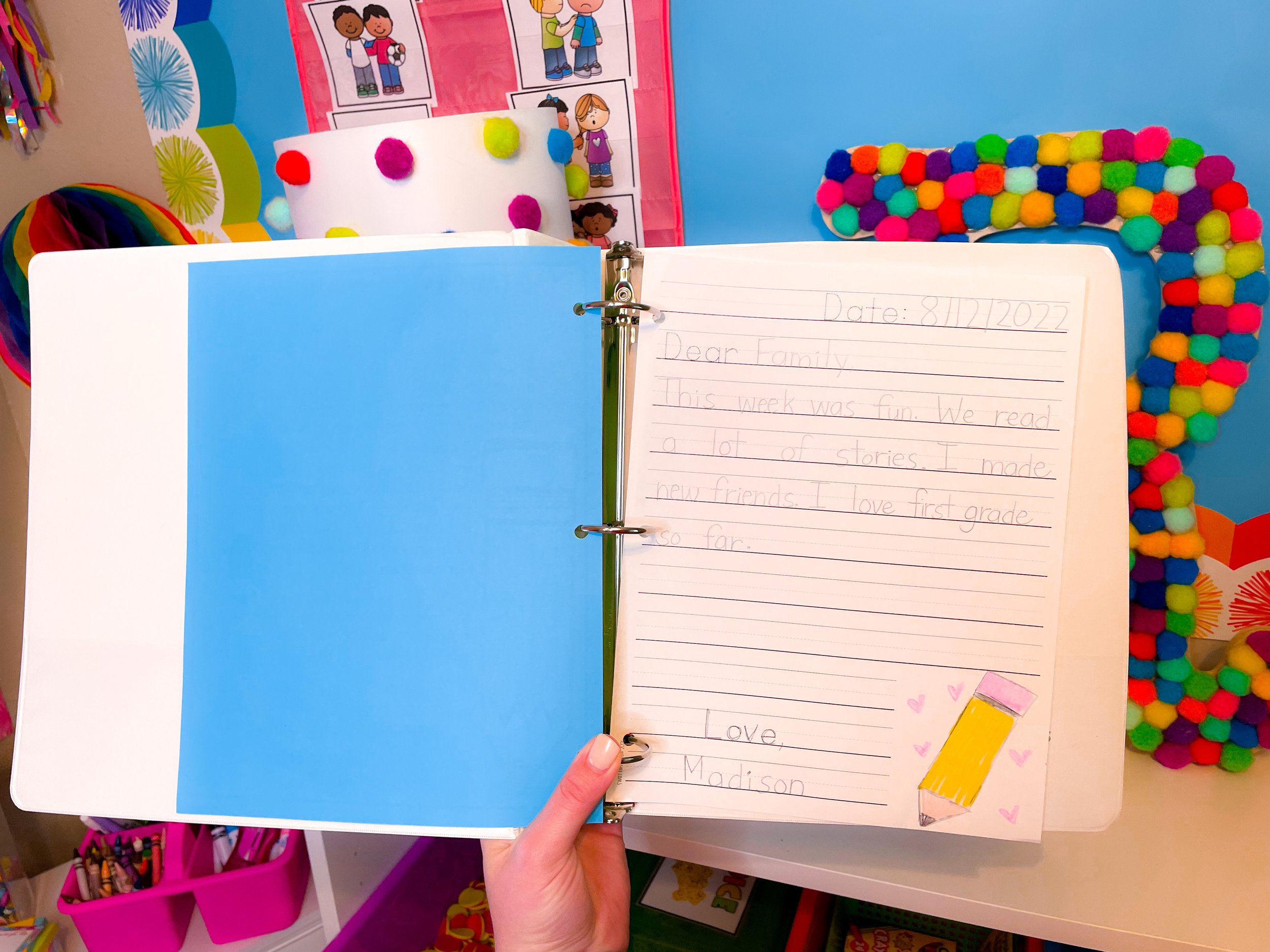Newsbooks… A Weekly Letter Writing Activity
The Weekly Newsbook is truly one of my favorite classroom traditions. Families “ooh and ahh” over this each year, and students love seeing their weekly writing growth.
This resource is helpful in many ways. It helps students learn how to write for an audience, and it makes them think about the events of each week. It serves as a growing portfolio of the student’s writing throughout the school year. It’s also a wonderful keepsake for families. I still get messages from past classroom families that mention how thankful they are to have a running track record of their student’s first grade year (or any grade that you are teaching).
Setting Up Your Newsbooks
I begin by purchasing a class set of 1.5- inch 3-ring binders. I buy the kind with the clear window in the front so that I can slide the cover page in. II don’t want the binders to be too big for student backpacks as they travel to and from school on Fridays and Mondays.
Next, I’ll print 3 pages on colored paper: the “My Newsbook” cover page, the “Dear Families” instruction letter*, and the “What I looked like on the first day of school” picture page. I print mine on bright colored Astrobrights paper. I never made my Newsbooks in color because I didn’t want to use that much colored ink. Haha! You’re welcome!
* The Instruction letter comes with pre-made letters, or a letter template for you to type in your own rules and instructions for your classroom Newsbooks
After printing and prepping, slide the cover insert in the front of the 3-ring binder.
Then, open the binder and insert the ”this is what I looked like on the first day of school” page. I take student pictures on the first day of school. I have them developed and then I tape them down with double-sided tape into the picture frame space on that page before Friday (our first day to write in Newsbooks).
Finally, place the “dear families” letter behind the student photo page. I always send families an email with the exact same letter on the first Friday afternoon of the school year so that they know what their child is bringing home. I also like to keep a paper copy of the letter in the Newsbook so that families remember what is expected of them.
Teaching How to Write Newsbook Letters
On Friday (generally before lunch), I bring students to the rug, and I tell them that they have one of the most important and exciting jobs in the school this year. Then I tell students that they will all be receiving a special book called a Newsbook where they will be writing the news from school each week! I tell students that it’s not any old book of news, it’s a special book where they get to write letters to their families filled with school news, and that their families will be writing them back! I tell students that their families are excited to see what they write each week, because our families don’t get to come to school with us every day and they want to hear all about what we learn and do at school each week.
Students usually get super excited when they see the Newsbook binder because it makes them feel very important and grown up. I tell them that it’s their job to write their best letter each week, get their Newsbook home safely, and bring it back to school on Monday morning so that they can read it (or I can help them read it).
For the first Newsbook letter, we all write the same thing together. We talk about how every letter starts with a greeting so that our families know who we are writing to. We talk about how every letter has a date at the top so that we know when we wrote it. We talk about how every letter has a body, where we write all our important and exciting things about the week. Finally, we talk about how every letter has a closing, where we write who the letter is from.
I usually place my stationary under the document camera, and students have the same sheet. Then we write the date together (I just do a number date 0/0/00), and we write Dear Family. After writing the date and the greeting, I teach students that we will begin every single newsbook letter with this sentence: “This week was _______.” I show them how to fill in the blank with a word that describes how their week was (later in the year when we learn grammar, I teach them that those are called adjectives).
After writing the date, greeting, and “This week was _______,” I tell students that since this is the first letter, and we will make it short and sweet since we are just getting started with our letter writing for the year and we will get better as we get bigger. I ask them to raise hands to share some of the things that we did this week. I scribe the most popular shared answers, and students copy for the first letter. The first letter might sound like this:
Dear Family,
This week was fun. We read a lot of good books. I made new friends. I love first grade so far!
Love,
________
After each student has finished writing the letter, I have them draw a small picture in the white space in the corner. Sometimes I’ll teach them how to do a little doodle (like how to quickly draw a school bus or an apple) and they’ll try it out on their own in that space.
Once students are finished writing/coloring, they bring their letter to me. I open their Newsbook binder (I don’t let them do it- I’ve seen too many tiny pinched fingers!), to the very last page so that the pages will be in chronological order. I place my hole-punched weekly newsletter in first, and then the student hole-punched letter behind mine. You don’t have to send home a paper newsletter this way, but I like keeping it in the Newsbook in front of the student’s letter so that families can read about the past and upcoming week from the teacher as well.
Over the weekend, families are instructed to write back a short and sweet letter on the back of the child’s Newsbook letter. They’re always so cute!
Writing Letters as the Year Goes On
Before every Newsbook writing time on Friday, I remind and model for students what they should have on their papers. On the document camera I always show them once again how to write the date, Dear Family, and This week was ________.
I usually write the second weekly Newsbook letter with students as well since our first week of school is never actually a full week, and I like to practice with them once again. After the second letter, I let students start writing the body themselves. I remind with the date, greeting, and opening sentence, but instead of writing the entire body, I just put key words on the white board to help students with spelling.
I do this by brainstorming what we did over the week with students for about 3 minutes before letting them begin. I have students raise their hands to share things about the week that they remembered, and I write the tricky words on the board. For example, if a student raises their hand and says, “this week we learned about magnets in science,” then I might write the words: “magnets”, and “science” on the board. I let students sound out the rest of the words in the sentence on their own. As the year goes on, I require students to write longer letters to help prepare them for the next grade level, and to build stamina.
NEWSBOOK FAQ
What if families don’t write back?
I’ll be completely honest, I have always worked in a school with high parent involvement, and I have not faced this issue. You could always switch up the concept of the newsbook and instead of writing Dear Family, you could have all your students write “Dear Newsbook” or “Dear Journal.” If you just have one student that constantly doesn’t receive a response, you could have them bring their book to the counselor on Monday morning so that he/she could write something short/sweet back for them to read in the classroom.
What if a student doesn’t bring their Newsbook back?
I would contact the family and let them know that the Newsbook is supposed to travel to and from school each week and that it’s important for their child to have a response to read on Monday morning. You can always reiterate that the response can be a few words. If a student just forgets their newsbook one day, just tell them to make sure to bring it back the next day. This usually is not an issue.
What if the child has a difficult time writing?
Our class brainstorm at the beginning of each Newsbook letter writing session always helps to generate lots of good ideas about what happened during the week, so “writer’s block” isn’t usually a problem. If a student was absent for most of the week, I just have them write a letter about what they were doing out of school and how they are glad to be back with friends.
If a student has difficulty writing because they lack foundational writing skills, I help them. I usually have 1 or 2 students that struggle with writing a letter, especially as the year goes on and I require students to write longer letters to prepare them for the next grade level. I bring those students to my small group table, and we generate sentences together, I scribe them on a white board (they’ll sound out each word with me and we will spell the words phonetically), and they usually copy. If the student SEVERELY struggles, then I will scribe what they want to say on their paper in highlighter, and they will trace over it. I start to wean them off this system over the school year by still having them trace over the highlighter, but I won’t scribe all the words in highlighter- I’ll leave blanks for words that are common and have those students write them in the blanks completely on their own (ex: words like: the, a, at, to, me, I, and, etc.).
Want to implement Newsbooks in your classroom this year?













